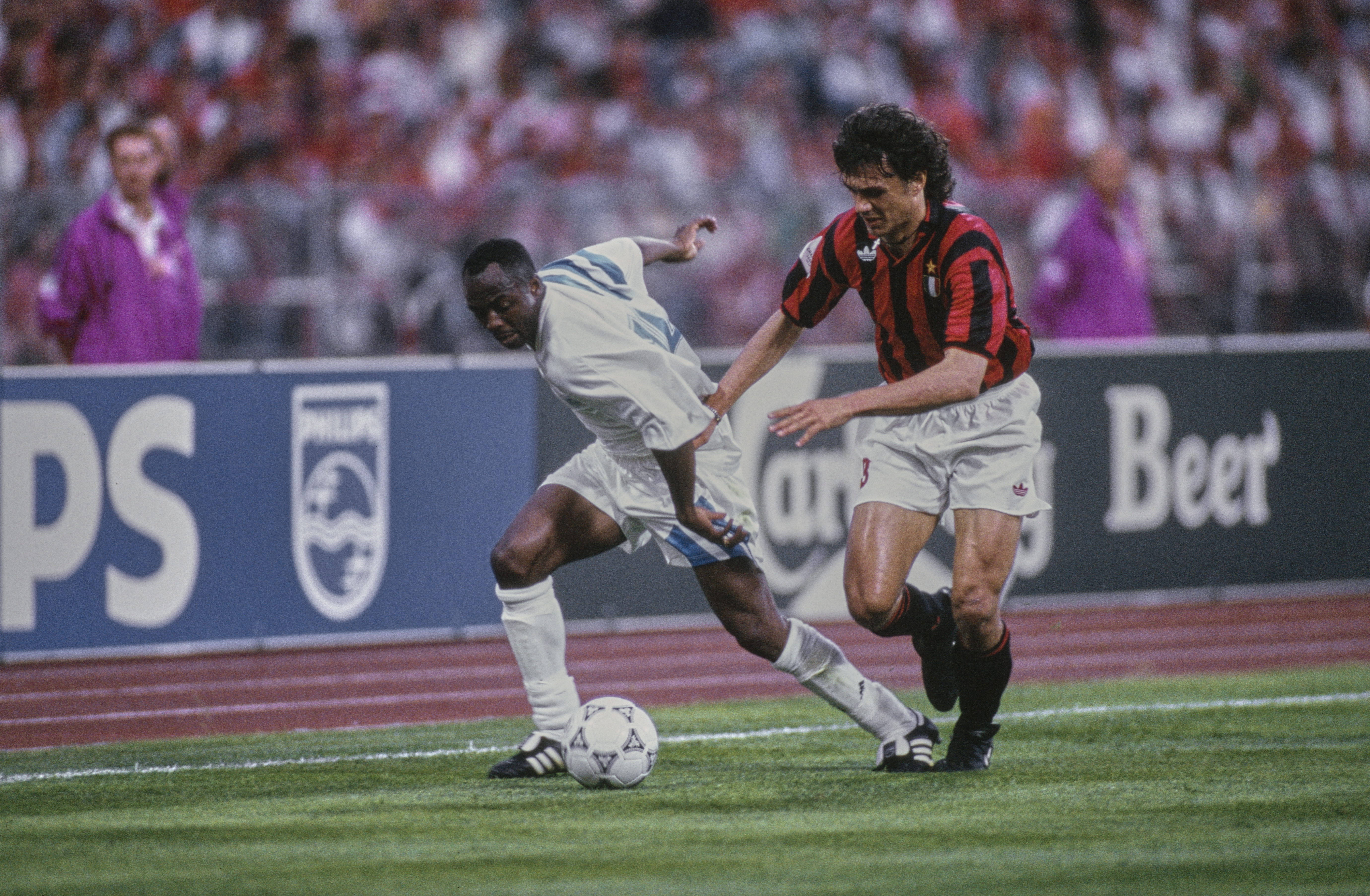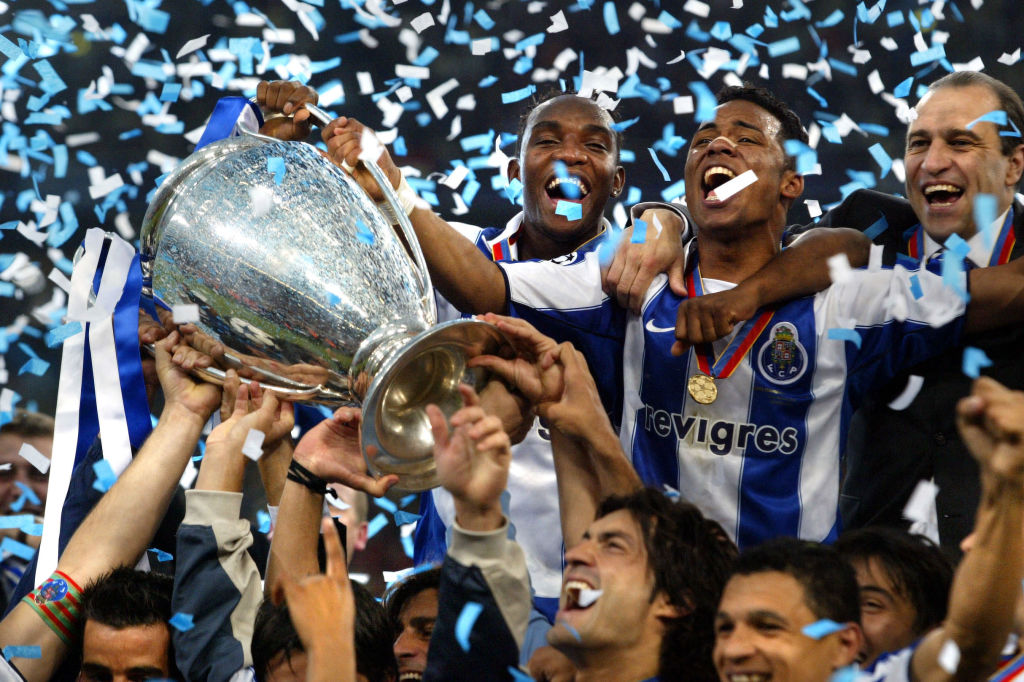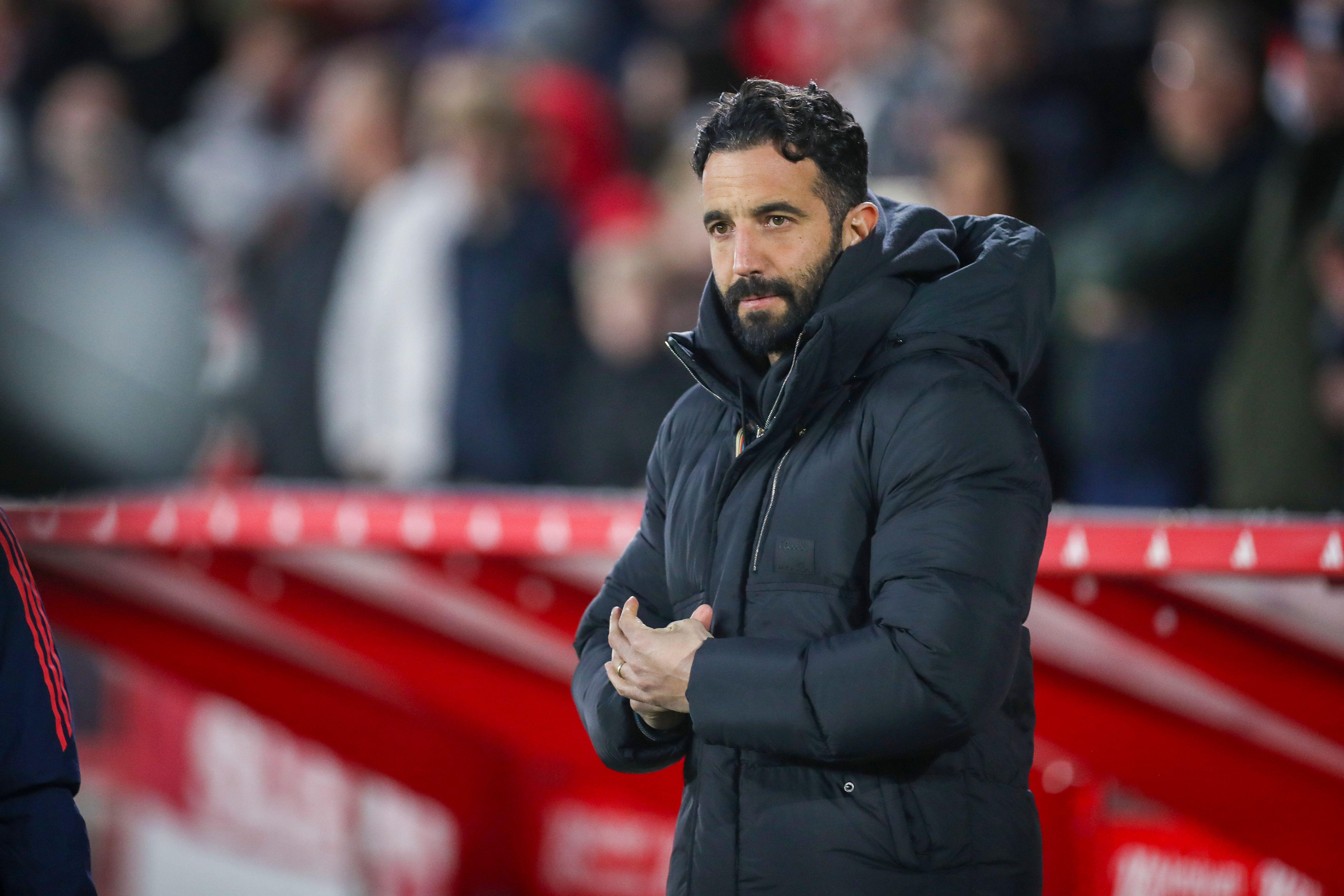Formations in football: Every modern formation and system
Your guide to every formation in football, from the defensive to the attacking and everything in between

Formations in football weren't a thing in the early days. This was a sport purely consisting of dribblers and tacklers in the 1800s – but oh, how far we've come.
Full-back formations: four-at-the-back
➝ 4-4-2 and its variations
↳ 4-4-2
↳ 4-4-1-1
↳ 4-1-2-1-2 (4-4-2 diamond)
↳ 4-1-3-2
↳ 4-2-3-1
↳ 4-2-2-2
↳ 4-2-4
➝ 4-3-3 and its variations
↳ 4-3-3
↳ 4-1-4-1
↳ 4-3-2-1
↳ 4-5-1
↳ 4-6-0
Wing-back formations: three/five-at-the-back
➝ 3-4-3 and its variations
↳ 3-4-3
↳ 3-4-2-1
↳ 3-4-1-2
↳ 3-2-4-1
↳ 3-1-3-3
↳ 5-2-2-1
↳ 5-4-1
➝ 3-5-2 and its variations
↳ 3-5-2
↳ 3-5-1-1
↳ 5-3-2
For the 50 or so years of the game, a 2-3-5 formation was the preferred mode across the game. It took Herbert Chapman of Arsenal to drop the middle player of that three deeper into the backline – hence the term, ‘centre-half’ – to a little disgruntlement from some, who believed defending as such as unsporting.
Over time, this W-M formation – named so for its resemblance to the letters – evolved even further. It was the Brazilians who dropped another player into the backline to form early 4-2-4 formations, while Helenio Herrera went even more defensive still, bolting the door on the attackers with his ‘catenaccio’ system.
Formations come into fashion before fading away, with the tides changing due to advancements in the sport. Changes in the offside rule, for example, are largely to blame for the sweeper's extinction in the modern game, which the development of sports science and player physicality in the 21st Century contributed to the renaissance of the high press and formations that suit it best.
In modern football, some managers choose to live or die by the one formation; others evolve along their careers. Ruben Amorim, for example, has virtually never played anything other than his trusty 3-4-3, while Carlo Ancelotti will famously bend his own ideas to the players at his disposal. Diego Simeone was a 4-4-2 evangelist at a time when it really wasn't popular to be; Marcelo Bielsa, meanwhile, famously coaches his players to play every formation he possibly can… while favouring an almost unique 3-4-3 with a diamond midfield.
Ultimately, they're all just numbers, aren't they? Well, you can split formations into four families.
- 2x CB, 2x CM: The most basic version of this is a 4-4-2. This gives you partnerships in the centre of defence and the centre of midfield to build with.
- 2x CB, 3x CM: Most commonly seen with the 4-3-3 shape, this provides a platform of a centre-back partnership, but establishes the more complicated three-man midfield, enabling you to grab a hold in midfield.
- 3x CB, 2x CM: From the 3-4-3 formation family, this combination shifts the trio further back, so you have more players in your own third – either to build up with or defend with.
- 3x CB, 3x CM: The most unusual formation family, most often seen with a 3-5-2, in which you aim to pack out both the defence and the midfield.
FourFourTwo has been at the forefront of footballing expertise for over 30 years, from a time in which almost the entirety of English football played with the formation we were named after, to an age in which footballing tactics are more idiosyncratic than ever.
In this tactical explainer, our experts will break down each formation family and its shapes, explain individual football terms and provide examples of teams who have played with these styles and systems in the modern game.
Don't forget that you can use our contents at the top of this page, too, for ease of access.
Get FourFourTwo Newsletter
The best features, fun and footballing quizzes, straight to your inbox every week.

It was Roy Keane who said, “We're all students of the game” – and for as long as I can remember, I've been obsessed with the tactical side of football. In my time at FourFourTwo, I've studied teams both high up in the stands and pitchside, while I've delved into tactical discussion in interviews with Premier League bosses.
Full-back formations: four-at-the-back
Full-back formations: four-at-the-back

➝ 4-4-2 and its variations
↳ 4-4-2
↳ 4-4-1-1
↳ 4-1-2-1-2 (4-4-2 diamond)
↳ 4-1-3-2
↳ 4-2-3-1
↳ 4-2-2-2
↳ 4-2-4
➝ 4-3-3 and its variations
↳ 4-3-3
↳ 4-1-4-1
↳ 4-3-2-1
↳ 4-5-1
↳ 4-6-0
Brazil's 1958 vintage weren't the first team to ever field a back four – legendary European Cup winner Bela Guttman developed a similar system independently – but the Selecao helped opened the eyes of the world to the possibilities of this set-up with their maiden World Cup win.
A quartet in the backline consists of two centre-backs and two full-backs. The full-backs traditionally support the attack, safe in the knowledge that two defenders are left behind to protect the centre of the pitch from transitions – and when the 4-4-2 rose to prominence in the 1990s, it made sense to field back fours in order to mark the front two and wingers of opposing teams.
Since the all-out-attack-minded Brazilian side of the '50s though, the back four has evolved with plenty of different ideas.
2x CB, 2x CM: 4-4-2 and its variations
2x CB, 2x CM: 4-4-2 and its variations

The 4-4-2 formation is unfairly associated in 2025 with less tactical coaches. We would say it's unfair – we're a little biased, right – but the basis of the 4-4-2 is the perfect ”starter formation” for any coach looking to get into the game.
Three's a crowd on a pitch. This formation family pairs players up with one another: two centre-backs, a full-back with each winger, a double-pivot in midfield and two strikers. Set your team up like this or similarly, and essentially, they will coach themselves: doubling up, tracking each other and one of them sitting while the other goes forward.
This is a big reason why the 4-4-2 is such a popular pressing shape. This family of formations allow for easy communication and simplified roles.
4-4-2
4-4-2
Associated with the early years of the Premier League, Arrigo Sacchi's Milan and, well, Mike Bassett, the 4-4-2 is thought of as a bog-standard My First Formation. Originally attributed to Soviet mastermind Viktor Maslov, the formation's genius lies in its simplicity and its perfect balance between stability at the back, strength in midfield and a threat in attack.
A flat 4-4-2 can be easy to play through, however, and difficult for a team playing in it to progress forward: its 90º angles encourage either sideways passing or extremely vertical line-breaking. It's possible to have the perfect profiles for this shape – Manchester United's Treble-winning 1998/98 side fielded two incredibly well-rounded midfielders in Paul Scholes and Roy Keane, between two elite wingers in David Beckham and Ryan Giggs.
More often than not, however, you'll see managers crowbarring in a midfielder into a wide position, a drifting forward alongside a target man and one full-back who wants to bomb, while the other sits. It's in the intricacies of this formation becoming naturally asymmetrical that it starts to come to life.
4-4-1-1
4-4-1-1
The penalty box is usually only big enough for one striker at a time. In a 4-4-2-like shape, pairing a natural poacher with someone a little more creative is a common solution.
A shape adored by Diego Simeone, the 4-4-1-1 drops one man closer to the midfield to link play. Often, this player will be the playmaker. That relieves the burden a little on the wingers, who will likely pack out the midfield and try and establish numerical superiority as a result. This is an underdog's shape – one favoured by the likes of Sean Dyche and Leicester City's 2015/16 title-winners – perfect for workhorses and a talismanic no.10 a-like.
4-1-2-1-2 (4-4-2 diamond)
4-1-2-1-2 (4-4-2 diamond)
The 4-1-2-1-2 – AKA 4-4-2 diamond, named so for that shape in the middle – is halfway between a 4-4-2 and a 4-3-3. There are four midfielders in the centre of the pitch, yes. But really, it's a 4-3-3 with a no.10 and a front two.
Often, playing a no.10 means sacrificing defensive solidity elsewhere – but not in the 4-1-2-1-2, which overloads the centre of the pitch with four players. The one thing that can make this formation fly, however, is its biggest weakness: the onus of width is on the full-backs to attack with the ferocity of wing-backs and get back to defend in a back four. Real Madrid have won Champions Leagues with this shape, with Roberto Carlos, Marcelo – two of the best left-backs in the world in their peak – but not everyone has such a luxury.
The 4-1-2-1-2 is increasingly these days used by the likes of Andoni Iraola and Pep Guardiola as a pressing shape, as it allows for a front two press a backline while another player behind tracks the cover shadow.
4-1-3-2
4-1-3-2
The rare beast that is the 4-1-3-2 is a compromised 4-1-2-1-2. The no.10 withdraws into a midfield three, sitting ahead of a lone no.6, with the wider no.8s able to explore the half-spaces or wider on the ball.
Milan adopted a style somewhere between the 4-1-3-2 and 4-1-2-1-2 during Carlo Ancelotti's heydey but the issues remain the same: a lack of width and the insecurity of two centre-backs rather than three. It's relatively unproven as a system at the top level on a consistent basis.
4-2-3-1
4-2-3-1
One of the most popular formations of the 21st Century, Spain (2010), Germany (2014) and France (2018) have all won World Cups with the 4-2-3-1. It offers the clear communication of a 4-4-2, allows for a creative no.10 dictating the heart of the attack and can allow its wingers and full-backs to push on and attack, with a clear bank of four defensive players – two centre-backs and two no.6s – to protect against counter-attacks.
Like the 4-3-3, the 4-2-3-1 allows for managers to assign specific midfielders to no.6, no.8 and no.10 roles, and to move on the pitch depending on game-state. The no.10, for example might press alongside the centre-forward, while managers like Pep Guardiola and Enzo Maresca will use an inverted full-back to push the no.8 further into attack, leaving a 3-2 shape both in build-up and in rest defence.
In most cases, a 4-2-3-1 demands wingers to track back and allows the no.10 to form overloads on either side of the pitch. This is a flexible formation, however, with modern coaches employing a range of tactical roles in its traditional positions to turn this shape into a 3-2-5 in attack or a 6-2-2 in defence.
4-2-2-2 (4-4-2 magic square)
4-2-2-2 (4-4-2 magic square)
Synonymous with the Red Bull group and coaches such as Ralf Rangnick and Marco Rose, the 4-2-2-2 is a similar formation to the 4-1-2-1-2. It overloads the central areas of the pitch, just like its cousin – but rather than building around one central creative figure, it places two attackers in the half-spaces for extra damage.
While at Leeds United, 4-2-2-2 enthusiast Jesse Marsch even dropped wingers into the centre of the pitch during build-up, in what can be a free-flowing and devastating formation for a counter. Just like a diamond midfield, however, the box midfield has just the same weakness: it requires a hell of a full-back pairing to provide the width.
4-2-4
4-2-4
Modern football is all about winning the midfield battle so it's rare that the 4-2-4 actually rears its head unless one team is desperately chasing a game. It certainly exists though, with Jurgen Klopp fielding a version of it just so that he could include Diogo Jota alongside his trusted trio of Sadio Mane, Roberto Firmino and Mohamed Salah – and in big games, too.
Vincent Kompany's Bayern Munich have resembled a kind of 4-2-4, while Mikel Arteta's Arsenal experiments without Martin Odegaard in the autumn of 2024 saw a version of this formation, too. The common denominator? A world-class midfield enforcer or two to ensure you're not steamrollered in the middle.
2x CB, 3x CM: 4-3-3 and its variations
2x CB, 3x CM: 4-3-3 and its variations

The 4-3-3 shape and its offshoots owe it all to one position: the no.6 or ‘pivote’ in Spanish. Spain saw a sword where others saw a shield.
Defensive midfield was considered purely protective cover for the defence in English football for a long time, but the no.6 became the most important player in any team with a revolution at Barcelona. Johan Cruyff opined that moving a playmaker deeper into a no.6 berth would enable him to see the whole game, with the role becoming the nucleus of a 4-3-3, controlling, anticipating and making an entire team tick.
Of course, not everyone saw the humble defensive midfielder as quite so progressive. Claude Makelele leant his name to a destructive role in that area of the field, while Klopp preferred to pack out the three-man centre-of-the-park, rather than give it expression. Ultimately, every shape under this umbrella shares the same goal, however: each aims for numerical superiority in the middle of the pitch, in one form or another.
4-3-3
4-3-3
As the likes of Jose Mourinho and Pep Guardiola have shown the world in the 21st Century, the 4-3-3 allows for fluidity and coverage of key areas of the pitch for a team looking to dominate.
The shape creates passing triangles, meaning that there's always a team-mate within 60º of your body shape, while the key attackers have access to the most dangerous areas. The no.8s can play in the half-spaces, the full-backs can overlap their wide attackers – knowing that their two centre-backs are protected by a no.6 and possibly even both no.8s – and these wide-attackers can cut inside to support the centre-forward.
A three-man midfield can often outnumber its opposition, too, with modern managers asking either a defender to step up and join that overload, or a false nine to drop back. There's less defensive burden on the wide attackers to track back than in a 4-2-3-1, given the coverage that a three-man midfield offers, while the relatively equal balance of numbers in defence, midfield and attack makes the 4-3-3 a good formation to transition into another shape – perhaps as a Plan B, or just when you're defending or attacking. A lot of modern managers will ask their team to attack in a 3-2-5 shape, which the 4-3-3 is the natural basis for.
4-1-4-1
4-1-4-1
The 4-1-4-1 is a more conservative version of the 4-3-3… or a more aggressive version, if you're Marcelo Bielsa employing counter-pressing no.10s in the central midfield roles.
This formation still utilises a lone pivot but uses it more as a screener for the backline, with a four-man midfield ahead akin to one you might see across the centre of a 4-4-2. This is a formation that lends itself well off the ball: a 4-3-3 will resemble a 4-1-4-1 when the wide attackers double up with the full-backs to mark opposition wingers, giving the two no.8s/no.10s a little more freedom centrally. It can, however, leave that lone frontman rather isolated if you fail to link the midfield the attack sufficiently.
4-3-2-1 (Christmas tree)
4-3-2-1 (Christmas tree)
Associated with Terry Venables during his time at Tottenham, the 4-3-2-1 is sometimes referred to as the ‘Christmas tree’ for its progressively narrowing shape from defence to attack. Similarly to a 4-3-3, it requires three attackers – though the wingers are so narrow, they're a ‘2’ behind the ‘1’ frontman.
Some 4-3-3s will resemble this too, of course. The key is in whether your wide attackers are truly forwards or playing behind a striker… and whether you can generate enough width from the back four to make this shape work. It's another narrow formation that relies on the engine of your full-back pairing – but since the 4-3-2-1 offers a ton of numerical superiority centrally, it's relatively fluid in attack, Carlo Ancelotti found fielding a version of this during his Milan days.
4-5-1
4-5-1
Traditionally, there have been two ways to compete against more dominant teams: pack out the defence and protect the area in front of your own goal, or pack out the midfield and look to win balls higher up.
The 4-5-1 is similar to the 4-1-4-1, lacking the defined no.6 role – many teams who play one of these two formations are misattributed as playing the other one – and as a result, it comes with the same strengths and weaknesses. It's very good for doubling up on opposition wingers and can contain a midfield but can also isolate a forward.
Perhaps the best example of it working to a tee was Arsene Wenger's Champions League finalists, Arsenal in 2005/06, who used creative midfielders across the five-man midfield, anchored by Gilberto Silva, with Thierry Henry needing virtually no support whatsoever to win games all by himself.
4-6-0
4-6-0
The 4-6-0 was first used by Luciano Spalletti's Roma, fielding Francesco Totti as a trequartista rather than a proper striker, while Spain used it in Euro 2012, opting for six pass-happy midfielders and Cesc Fabregas as a runner from deep (intriguingly, not as a false nine, as is sometimes claimed).
It's virtually the same as a 4-3-3 – just without the obvious centre-forward. It all boils down to the front three and the semantics of whether you're playing with a false nine or no forward at all. It's an unusual shape in that its strengths and weaknesses are plainly obvious – bountiful midfield numbers, with the final third neglected – but find the right centre-forward and this is a shape that can click.
Wing-back formations: three/five-at-the-back
Wing-back formations: three/five-at-the-back

Three-at-the-back is often thought of as no more than a defensive-first solution: it's common to see managers chuck another defender into the mix to shore things up, after all. Given that so many managers split their attack into five channels, it makes sense to cover each with a defensive presence.
This is just one function of a back three or five, though – depending on how you view a wing-back. Three centre-backs can give you an extra body in build-up to play up the pitch: it can unleash your wide defenders high, too, allowing attackers in your team to play narrower and closer to goal.
Building from the back is a common philosophy to win titles. But it's how a three-man backline can allow the rest of the team to flourish that most managers choose it.
3x CB, 2x CM: 3-4-3 and its variations
3x CB, 2x CM: 3-4-3 and its variations

While the 4-3-3 relies on the communication and trust of a centre-back pairing behind the more complex three-man midfield, the 3-4-3 shape does the opposite. Like a three-man midfield, the middle centre-back is often the organiser, the best long passer and exerts the least stamina, with the two either side being the aggressive defenders who look to play progress play, even dribbling forward.
Placing the numerical superiority further back allows for another benefit: with the rise of the high press has come the rise of building play out from the back. The most common build-up shape is a 3-2 – with three defenders in the first line and two midfielders in the second – all about a 60º angle away from one another. While some managers contort a back four to make this shape, others use a simple 3-4-3 – or variant – with wing-backs providing support in attack.
3-4-3
3-4-3
The formation, “3-4-3” can be used to describe any variant of the shape with three attackers, whether one or two of those attackers are withdrawn. But 3-4-3s with wide attackers – akin to a 4-3-3's wide-men – still have their place in the modern game.
Thomas Tuchel's Chelsea played a form of this with three attackers pressing high in the side and no fixed idea of which ones would drop deep to link with the midfield. Mikel Arteta's Arsenal won an FA Cup in 2020 with Nicolas Pepe and Pierre-Emerick Aubameyang either side of Alexandre Lacazette, in what was an attack-heavy front three ahead of width-holding wing-backs, while Arteta's mentor, Pep Guardiola, has at times operated with this formation, too – using it to match up with back-three enthusiasts Tuchel and Antonio Conte when he faced them both in the Premier League.
3-4-2-1
3-4-2-1
The version of the 3-4-3 that Antonio Conte brought into vogue in the Premier League and beyond, this version of the formation uses two attackers behind a central striker, rather than beside. While both players can get up and support their no.9, they can also drop into more of an attacking midfield position, forming a box midfield with the double-pivot behind them.
The 3-4-2-1 has become the three-at-the-back formation of choice in the modern game because it offers this numerical superiority in the centre of the park, ahead of a sturdy defensive base and consistent width from the wing-backs. It can transition very easily into a 3-2-5 to dominate in the final third – as Bayer Leverkusen have done under Xabi Alonso – while its attacking midfielders can be given a huge amount of creative expression with a manager able to choose up to seven defensive players behind them.
The key to this formation – and many other back-three systems – lies in that very balance. Employ a mercurial talent like Eden Hazard in Chelsea's 2016/17 3-4-2-1 and you can unleash a superstar behind what is essentially two brick walls. But this formation relies on a smattering of players equally good going forward as backwards. Finding free-flowing expression from such a rigid structure is tricky for any coach.
3-4-1-2
3-4-1-2
Some consider this shape a kind of 3-5-2, thanks to the presence of three midfielders, even if one is advanced of the other two – but the double-pivot behind a central creative force at no.10 distinguish this formation firmly as a 3-4-3 with a variation in the front three.
This is a shape that can help carry a ‘luxury player’ in attacking midfield role – Unai Emery opted to use it in his Arsenal days to get Mesut Ozil behind Aubameyang and Lacazette without sacrificing solidity behind them – but the same issues can exist as with any 3-4-3. The presence of up to seven defensive-minded players needs to be weighed up, however good the 3-4-1-2 is for its duel-ability to both soak up pressure and provide an expressive playmaker.
3-2-4-1 (3-box-3)
3-2-4-1 (3-box-3)
The super-attacking 3-2-4-1 with which Manchester City won a Treble in 2022/23 was born from a simple 4-3-3. With centre-backs across the backline, Pep Guardiola pushed the no.8s up to support in a five-man attack across the channels, with one of the defenders joining the no.6 to build a double-pivot. This shape became so renowned that City were listed in line-up as playing with it from the start – and often did in games in which they sought to dominate and pen opponents in their own third.
The benefits are huge. The 3-2-4-1 offers that common 3-2 build-up with 60º angles for players to pass around, while the same passing triangles appear in the attack. The double-pivot provides a sturdy base in defensive transition, while one of those two midfielders can drop back into the first line to recreate a 4-3-3/4-1-4-1 shape if need be. A box midfield offers dominance centrally – and attacking midfielders in the half-spaces – while the lack of traditional full-backs means that you can dedicate those two roles to players who are perhaps a little more rounded as players.
But this shape isn't without its drawbacks. While passing triangles are prevalent in defence and attack, the sharp 90º angles from the defensive midfield ‘2’ to its attacking midfielders ahead force verticality, while the lack of overlap from any full-backs means that wide men can struggle to impact games without positional fluidity. This is a formation that suits a team with specific dynamics in defence and forward areas: when it comes together, it can blow teams away but requires high levels of technical quality and movement.
3-1-3-3 (3-diamond-3)
3-1-3-3 (3-diamond-3)
A formation that has foundations in the ‘total football’ philosophy of the Netherlands, the 3-1-3-3 – sometimes referred to 3-diamond-3 or 3-4-3 diamond – is also referred to as a 3-3-3-1 or 3-3-1-3, depending on whether you wish to emphasise the no.6, no.10 or no.9. While this shape could also be considered part of the 3-5-2 family, it's listed here for the same reasons a 4-1-2-1-2 is considered a 4-4-2 and not a 4-3-3 (still following?): it rotates a four-man midfield.
A staple of Barcelona teams under Johan Cruyff and Pep Guardiola, as well as various Marcelo Bielsa sides, the formation builds around a central lone pivot but offers numerical superiority in the shape of three other midfielders around. It provides passing triangles across the pitch and enables its midfielders to drift and find spaces in the attack – while off the ball, the no.8s can drop back and provide a kind of back six if need be.
The existence of the lone no.6 and lone no.10 can be easily targetable, however, requiring the players in this shape to be incredibly well-drilled and diligent with their movement and positioning. The 3-2-4-1's issue of the forwards struggling to get into the game exists, too, while wide areas are easy to target with a 3-1-3-3 if the midfield isn't coordinated to defend these spaces. It's no wonder that this is a shape used by coaches who preach cohesion and incredible levels of fitness.
5-2-2-1
5-2-2-1
One way to prepare your team to soak up pressure without immediately ceding the midfield battle is to turn a back three into a five – by dropping the wing-backs – and bringing a box midfield into the centre of the park.
This is a shape that plenty of 3-4-2-1 managers will adopt in a low block, though some choose to start with it and counter-attack. Its strengths in defensive numbers are obvious but it asks a lot of its four-man midfield to get onto the ball. It can be incredibly isolating for a no.9 without any obvious area for a runner to support.
5-4-1
5-4-1
Like the 5-2-2-1, the 5-4-1 can be an optimum solution for soaking up pressure but comes with the same drawbacks of isolating its no.9. It allows for two wingers to double up on opposing wide attackers while usually asking for its double-pivot to also screen that back five.
As you can imagine, up to nine defensive presences in this one formation mean that it isn't a particularly popular one among ambitious coaches – but it's still found success over the last couple of decades from managers looking to shut up shop against significantly more talented teams. If you can't relieve 90 minutes of pressure every now and then with your lone forward holding up the ball and encouraging the rest of the team up the pitch, however, it's a long old afternoon employing this shape.
3x CB, 3x CM: 3-5-2 and its variations
3x CB, 3x CM: 3-5-2 and its variations

Why choose between three centre-backs and three central midfielders?
That's the thought process of the likes of Rudi Garcia, Diego Simeone, Thomas Frank and Simone Inzaghi, whose 3-5-2 shapes are far less conservative than at first glance. The 3-5-2 enables for central coverage in the first and second phase, giving a manager optimum control without sacrificing the space in front of the goalkeeper – and while this family of formations is the most unusual, there are famous examples of this basic shape thriving in the modern game.
3-5-2
3-5-2
The 3-5-2 offers key coverage from the back forward. The three centre-backs offer numerical superiority during build-up, while in theory, three midfielders controlling and dictating in the centre of the park means that the wing-backs can be a little less box-to-box – though they're still key to both the defensive and offensive potential of this shape.
The attack offers a double threat, too, with this shape often combining little-and-large partnerships in attack. There's no luxury playmaker, however, with the 3-5-2 a little less expressive than a 3-4-1-2 – unless the no.8s can drift higher into the half-spaces.
3-5-1-1
3-5-1-1
The 3-5-1-1 carries the same strengths as the 3-5-2, though makes a clear distinction in attack: one forward will link play with the midfield, while the other toils further ahead.
While this shape can enable a little more creativity than its sibling, it places a heavier burden on the no.9. England used this shape to incredible effect at the 2018 World Cup, using Harry Kane as a complete forward capable of holding up the ball, not just for Raheem Sterling behind him, but for no.8s Jesse Lingard and Dele Alli to get involved in attack as spare men, while Sterling himself could attract defenders to him with his movement in what was essentially a free-roaming role.
5-3-2
5-3-2
The 5-3-2 and 4-4-2 are the two most popular deep block formations in the modern age. This is thanks to the presence of two clear targets in attack, with one able to win aerial duels for the other to run onto.
There is a choice to be made on whether you favour the 5-3 or 4-4 shape, however. As mentioned further up, a 4-4-2 is the easiest shape to coach, offering ample coverage in two blocks of four across the key areas of the pitch when a team remains compact – but the 5-3-2 offers five defenders to each defend a five-man attack, a three-man midfield to offer control and preferable passing angles in build-up to a 4-4-2.
For some coaches, the build-up in a low block is entirely bypassed with route one balls up to the target men, making the 4-4-2 an easier choice for communication. But when well-coached, a 5-3-2 can be a phenomenally difficult shape to break down, with even more progressive coaches like Ruben Amorim and Mikel Arteta employing it expertly to stump better teams in big games.
Frequently asked questions
What is a football formation?
A football formation is the tactical arrangement of players on the field, defining their roles and positioning in attack and defence. It influences a team's playing style and strategy.
Why are football formations important?
Formations help teams maintain structure, optimise strengths, cover weaknesses, and adapt to opponents. They affect ball control, defensive solidity, and attacking effectiveness.
How does a manager decide on the formation in football?
Managers consider player strengths, opposition tactics, match conditions, and game objectives when choosing a formation. They may also adjust formations mid-game based on performance.
Can a team change formations during a match?
Yes, teams often switch formations based on game situations. Tactical substitutions, positional shifts, or changes in strategy can alter the formation dynamically.
What is a 'fluid formation'?
A fluid formation allows players to interchange positions seamlessly, making the team unpredictable. It relies on intelligent movement rather than rigid positional play.
What is a hybrid formation?
A hybrid formation blends elements of multiple setups, adjusting dynamically between attack and defense. For example, a team might defend in a 4-5-1 but switch to a 3-4-3 when attacking.
How do formations impact player roles?
Formations dictate whether players take on defensive, playmaking, or attacking roles. A midfielder in a 4-3-3 may play deeper as a pivot, while in a 4-2-3-1, they may have more attacking freedom.
What is the difference between zonal and man-marking in formations?
Zonal marking assigns players to defend spaces rather than individuals, suiting structured formations. Man-marking involves tracking opponents directly, often used in aggressive or counter-pressing systems.
Why do some formations struggle against others?
Certain formations counter others due to numerical advantages in key areas. For example, a 4-4-2 can struggle against a 4-2-3-1 because of midfield overloads.
Which formation is best for Football Manager?
The 4-2-3-1 gegenpress formation is a popular Football Manager tactic. This setup offers defensive solidity while providing multiple numerical advantages in advanced areas. It transitions fluidly between defensive and attacking phases, making it versatile against different opponents.
Which formation is best for EA Sports FC?
The 4-3-2-1 formation is favoured by many pro players due to its compact defense and versatile attack. It provides numerous passing options, facilitating quick ball movement and effective progression through the opponent's defense. This formation emphasises central play, with two attacking midfielders supporting the lone striker, creating a dynamic offensive threat.

Mark White has been at on FourFourTwo since joining in January 2020, first as a staff writer before becoming content editor in 2023. An encyclopedia of football shirts and boots knowledge – both past and present – Mark has also represented FFT at both FA Cup and League Cup finals (though didn't receive a winners' medal on either occasion) and has written pieces for the mag ranging on subjects from Bobby Robson's season at Barcelona to Robinho's career. He has written cover features for the mag on Mikel Arteta and Martin Odegaard, and is assisted by his cat, Rosie, who has interned for the brand since lockdown.
